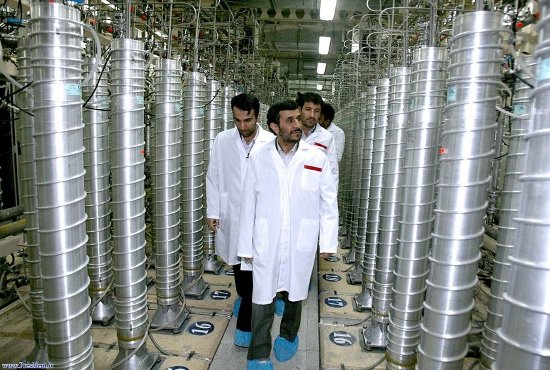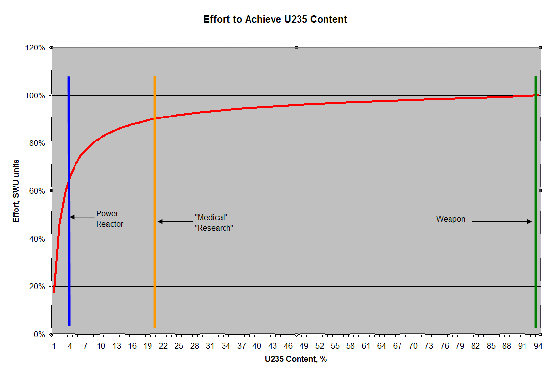|
|
|
Iranian President Mahmoud Ahmedinejad tours a centrifuge facility. |
Iran reports having thousands of centrifuges spinning away to make fuel for their upcoming power reactors. Others think that Iran has it in mind to make weapons material using those same centrifuges. In fact, Iran could divert just 1% of its centrifuge production and have enough weapons-grade material to make a few bombs per year. The arithmetic is provided here below.
Note: I was with Westinghouse civilian nuclear power for 30 years as a registered professional engineer with nuclear specialization. I hold a doctorate in engineering. All information here is unclassified.
Uranium bombs are very simple. Take two lumps of U235, slam them together using regular explosives, and the uranium will detonate.
But where to get the U235 to produce the bomb? Out of the ground, except that uranium extracted from the ground is 99.3% U238, an uranium isotope that won’t work in a bomb. Only 0.7% of uranium out of the ground is U235. Normal chemical operations won’t separate the isotopes, so it is necessary to find a process that can work on the slight difference in mass or the very slight difference in chemical potential. Centrifuges are a popular method to extract the minute quantities of U235 from uranium ore. Centrifuges (cyclotrons) contributed U235 to the Hiroshima bomb in 1945, and Iran has modern centrifuges today.
The separation of U235 from the ore is done in stages, thousands of stages, because the gain per stage is very slight. The number of stages can be calculated quite easily.. Wikipedia gives the equations and a general discussion.
The separation effort is measured in “separative work units,” SWUs, pronounced, of course, “swoos.” Separation starts with feed material and produces “product” with a slightly higher concentration of U235 and “tails” with a slightly lower concentration of U235. One hundred percent separation is never achieved, and picking a tolerable amount of U235 to be left in the tails is a matter of economic optimization. Tails with 0.3% U235 are mentioned in the literature, which is to say on the order of 4/7 of the original U235 goes into product and about 3/7 does not. The product of one stage is fed into the next, over and over again.
The centrifuges don’t care what the mix is, and one centrifuge, used over and over again, can do the whole job. In practice, thousands of centrifuges are used to get more product per week and month.
As noted above, uranium out of the ground is 0.7% U235. The uranium used in commercial power reactors has about 4.5% U235. The uranium used in nuclear weapons is around 94% U235. Looking at those numbers, one might think that getting up to reactor-grade would be easy and getting up to weapons-grade would be hard. Not so. Two-thirds of the effort goes into getting the natural uranium up to reactor-grade, and only one-third of the effort is expended to finish making weapons-grade uranium. More on that below.
Recent press coverage has dwelt on “medical grade uranium” and “research reactor uranium.” Uranium has little or no medical value itself, because uranium is very nearly inert. Uranium can be converted to other materials of substantial medical value, though, by directing a stream of neutrons onto uranium, causing U235 in the uranium mix to undergo fission. For instance, uranium fission produces an element which changes spontaneously to Yttrium-99, a very handy material for attacking cancer cells. The U235 being targeted for this indirect medical purpose can be in uranium right out of the ground or uranium whose U235 content has been boosted.
The point here is that there is no specific need to enrich uranium to 19.9%, as mentioned in the press, for medical purposes. That’s a smoke screen.
Recent press coverage has also mentioned “research reactor uranium” with, again, 19.9% U235. There are research reactors that use uranium right out of the ground, research reactors that use weapons-grade uranium, and everything in between. This is another smoke screen.
Let’s look at some numbers. Let’s say we want to produce 20 kilograms of U235, which is plenty to make a uranium bomb, provided that it is 90+ % U235. Let’s say 94%.
Making 20 kg of uranium having 94% U235 content is going to take 4,048 SWUs, starting with uranium out of the ground. However, if an inventory of “medical grade” uranium happens to be on hand, then only 403 SWUs are required to finish the job, producing 20 kilograms of uranium made up of 94% U235. Thus, if you start with “medical grade” uranium, you are 90% of the way there.
Alternatively, if an inventory of reactor-grade uranium happens to be on hand, then 1,375 more SWUs are required to finish the job. Reactor-grade uranium is 66% of the way there.
A standard power reactor that generates electricity requires about 20 tons of uranium a year, utilizing uranium with about 4.5% U235 content. A centrifuge facility intended for this civilian use would be spinning thousands of centrifuges to do 106,000 SWUs each year. Diverting a bit of that 4.5% U235 and adding just 1,300 SWUs of additional effort would yield 20 kilograms of 94% U235. If this were to be done on the sly, about 1% of the total centrifuge work would have to be falsely labeled or otherwise disguised. Diligent inspectors might catch this, or they might not.
Are you a dedicated reader of FDD's Long War Journal? Has our research benefitted you or your team over the years? Support our independent reporting and analysis today by considering a one-time or monthly donation. Thanks for reading! You can make a tax-deductible donation here.










4 Comments
Wow! Just everyone remember 5 years ago they said this was the year Iran would have the bomb. Few months to go eh… Best part of nukes is that they stop wars (once used). Iran has been at war with us 30+ years, what do you think they would do to stop this war they say we started? Hang on to your butts…
I’ve reported that the Iranian nuke materials are
corrupted.
“The impurities, certain metallic fluoride compounds, would interfere with centrifuge enrichment” at Iran’s facility at Natanz
“That is because re-enrichment by Iran of the LEU processed at Natanz without decontamination could destroy centrifuges used for this purpose.”
Can you confirm?
http://warintel.blogspot.com/2009/10/iran-epic-nuke-fail.html
Gerald
Anthropologist
I recently read Iran’s inspected Uranium stocks were contaminated with
molybdenum or some other contaminants that would either hinder or keep
Iran from enriching their feedstock, using their current, known
enrichment techniques. The reference cited was a nuclear journal
(which I cannot find). Is this true or another smoke screen? Would
the outsourcing enrichment for Iran’s “medical” purposes be a way of
enriching their feedstock, to a point they are not currently capable
owing to the contamination, so they can later finish enriching on their
own for nuclear weapons construction?
Regarding contamination: lots of people have figured out how to make these centrifuges work, so the Iranians will, too. Contamination-cleanup only requires standard chemical engineering, nothing nuclear. There is no need for nuclear shielding … although it’s a good idea to keep things separated so that no critical mass develops by accident. This is easy to do and is well documented. As to the value of having Russians or others do some enriching, think back to the negotiations with North Vietnam. The first several months were taken up with negotiating the shape of the table. One might guess that that’s what’s going on here.